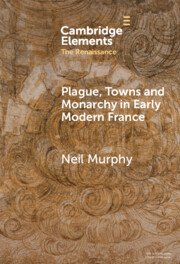Refine search
Actions for selected content:
91 results
7 - The Churches Are Empty, the Priests Are Silent
-
- Book:
- Death and the Afterlife in Syriac Christianity
- Published online:
- 17 December 2025
- Print publication:
- 22 January 2026, pp 192-220
-
- Chapter
- Export citation
7 - Public Health
- from Part II - Application Case Chapters
-
- Book:
- Cities and Environmental Change
- Published online:
- 15 August 2025
- Print publication:
- 28 August 2025, pp 134-158
-
- Chapter
- Export citation
Chapter 4 - Daily Domestic Devotion and Preparation for Death
-
- Book:
- Birth, Death, and Domestic Religion in Early Modern London
- Published online:
- 17 July 2025
- Print publication:
- 31 July 2025, pp 125-158
-
- Chapter
- Export citation
The Plague of Provence (1720–2) and debates in Britain on the cross-species transmission of disease
-
- Journal:
- Medical History / Volume 69 / Issue 3 / July 2025
- Published online by Cambridge University Press:
- 14 July 2025, pp. 356-373
-
- Article
-
- You have access
- Open access
- HTML
- Export citation
Bayesian modeling of a medieval plague and famine mass graves from Sedlec-Kutná Hora, Czech Republic
-
- Journal:
- Radiocarbon / Volume 67 / Issue 4 / August 2025
- Published online by Cambridge University Press:
- 13 June 2025, pp. 819-830
- Print publication:
- August 2025
-
- Article
-
- You have access
- Open access
- HTML
- Export citation
5 - Economies, People, and Nature
-
- Book:
- Merovingian Worlds
- Published online:
- 22 November 2024
- Print publication:
- 05 December 2024, pp 143-172
-
- Chapter
- Export citation
The first mitogenome of the genus Amphalius (Siphonaptera: Ceratophyllidae) and its phylogenetic implications
-
- Journal:
- Parasitology / Volume 151 / Issue 10 / September 2024
- Published online by Cambridge University Press:
- 03 December 2024, pp. 1085-1095
-
- Article
-
- You have access
- Open access
- HTML
- Export citation
Chapter 29 - Infectious Disease and Its Repercussions in Sixth-Century Antioch
- from Part V - Crises and Resilience
-
-
- Book:
- Antioch on the Orontes
- Published online:
- 06 June 2024
- Print publication:
- 06 June 2024, pp 464-488
-
- Chapter
- Export citation

Plague, Towns and Monarchy in Early Modern France
-
- Published online:
- 25 April 2024
- Print publication:
- 25 April 2024
-
- Element
- Export citation
Plague and the Mongol conquest of Baghdad (1258)? A reevaluation of the sources
-
- Journal:
- Medical History / Volume 68 / Issue 4 / October 2024
- Published online by Cambridge University Press:
- 08 April 2024, pp. 392-410
-
- Article
-
- You have access
- Open access
- HTML
- Export citation
Chapter 2 - A World Full of Risks
-
- Book:
- Risk in the Roman World
- Published online:
- 16 November 2023
- Print publication:
- 30 November 2023, pp 15-31
-
- Chapter
- Export citation
Chapter 14 - Health
- from Part II - Contexts and Controversies
-
-
- Book:
- The Cambridge Companion to Literature and Animals
- Published online:
- 26 October 2023
- Print publication:
- 09 November 2023, pp 252-269
-
- Chapter
- Export citation
Chapter 10 - ‘For Thy Kingdom Is Past Not Away, / Nor Thy Power from the Place Thereof Hurled’
- from Part III - Divine Transcendence and Pragmatic Purposes
-
-
- Book:
- Divination and Revelation in Later Antiquity
- Published online:
- 19 October 2023
- Print publication:
- 02 November 2023, pp 191-207
-
- Chapter
- Export citation
Chapter 3 - Past and Future in the Iohannis
-
- Book:
- War, Rebellion and Epic in Byzantine North Africa
- Published online:
- 12 October 2023
- Print publication:
- 26 October 2023, pp 86-127
-
- Chapter
- Export citation
4 - Exogenous Loss of Labor
-
- Book:
- Shocking Contrasts
- Published online:
- 09 June 2023
- Print publication:
- 17 August 2023, pp 55-82
-
- Chapter
- Export citation
Artaud’s Civil War: ‘Theatre and the Plague’ in the Time of Covid-19
-
- Journal:
- New Theatre Quarterly / Volume 39 / Issue 3 / August 2023
- Published online by Cambridge University Press:
- 28 July 2023, pp. 262-271
- Print publication:
- August 2023
-
- Article
-
- You have access
- Open access
- Export citation
11 - Chinese Expansion in Eighteenth-Century Central Eurasia
- from Part IV - Migration by Land
-
-
- Book:
- The Cambridge History of Global Migrations
- Published online:
- 12 May 2023
- Print publication:
- 01 June 2023, pp 219-239
-
- Chapter
- Export citation
Chapter 5 - ‘Soveraignes have a sympathie with subjects’
-
- Book:
- Sympathy in Early Modern Literature and Culture
- Published online:
- 27 April 2023
- Print publication:
- 13 April 2023, pp 176-214
-
- Chapter
- Export citation
Chapter 2 - From the Black Death to the Tudor Suppressions
-
- Book:
- The Dominicans in the British Isles and Beyond
- Published online:
- 02 March 2023
- Print publication:
- 09 March 2023, pp 66-110
-
- Chapter
- Export citation
16 - Thucydides in Byzantium
- from Part III - After Thucydides
-
-
- Book:
- The Cambridge Companion to Thucydides
- Published online:
- 02 March 2023
- Print publication:
- 09 March 2023, pp 249-264
-
- Chapter
- Export citation
